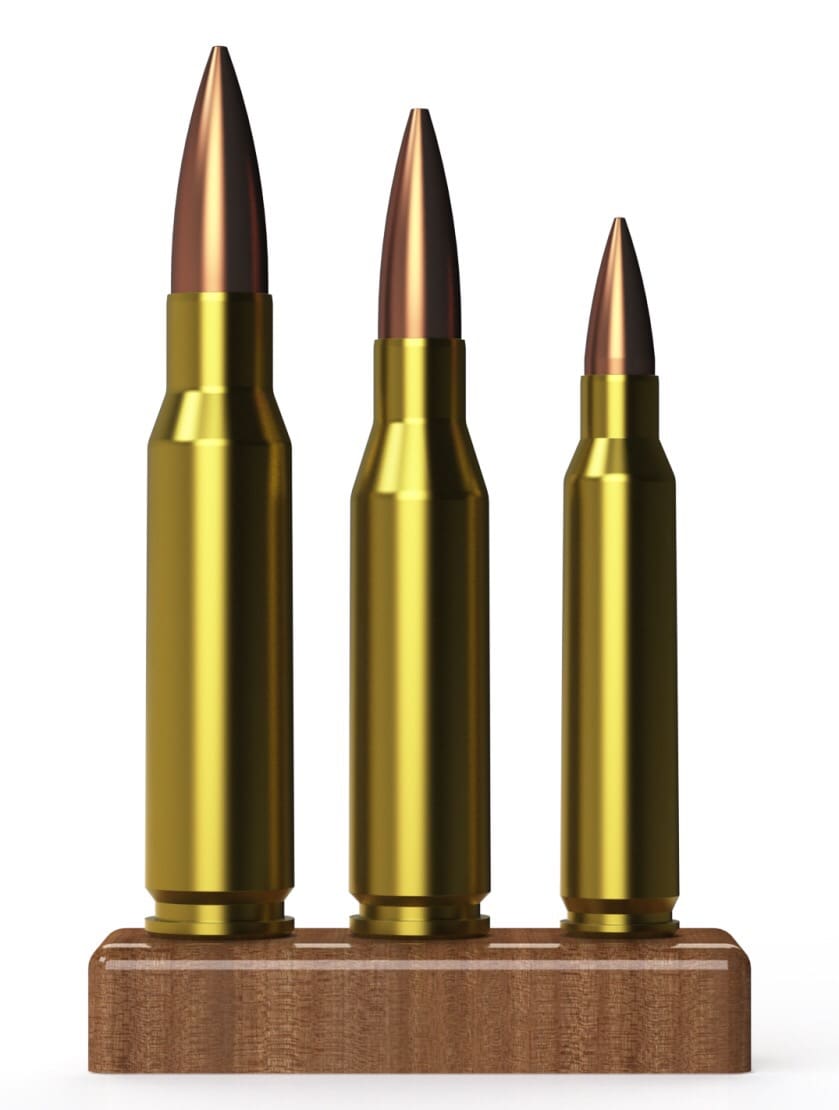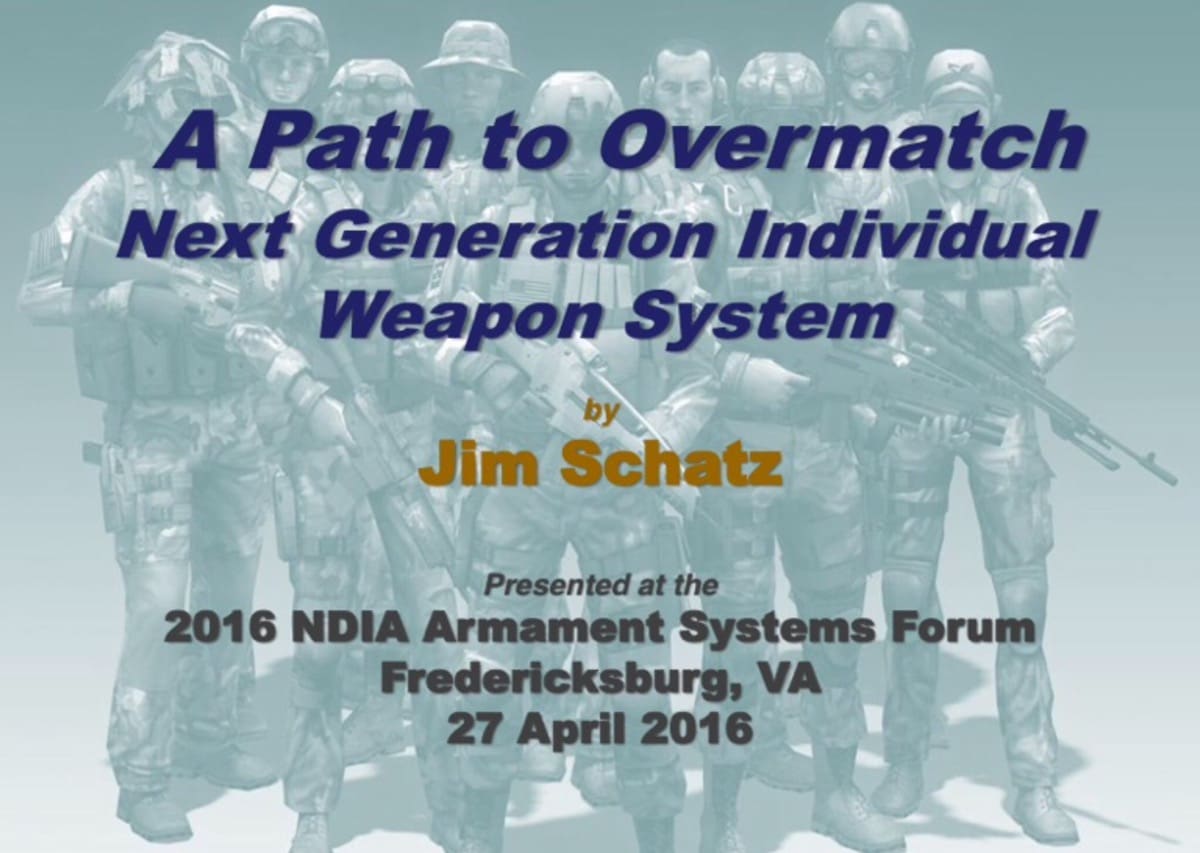Recently, I’ve started resharing some briefings by the late, great Jim Schatz. I originally shared this one in April 2017, right as the Army was taking its first steps toward what is now Next Generation Squad Weapons. As we head into SHOT Show, now is a great time to take a look at what both the Army and SOCOM have accomplished and consider the path that Jim proposed.
One thing he mentioned was the concept of “Frontliners” which has been institutionalized as the Close Combat Force. Other ideas have seen varying degrees of interest.
He was always on top of past missteps in the opportunities we’ve had to modernize our small arms. His last briefing to NDIA’s Armament Systems Forum, on 27 April, 2016 was entitled, “A Path To Overmatch” and made the case for an immediate transition to an intermediate caliber, preferably with a telescoping cased cartridge, along with a new weapon individual weapon. His reasoning was simple; overmatch. Our troops remain outranged by threat weapons firing the 7.62x54R cartridge. While not every enemy is equipped with a weapon in this caliber, they’ve learned to use their PKM MMGs and SVD Sniper Rifles to keep our troops at arm’s length. In the briefing, Jim does a great job of laying out Russian and ISIS capabilities vis-a-vis our US M4A1 and M249.
Jim named five things that could immediately be leveraged to provide overmatch: Lightweight Intermediate Caliber Cartridge (LICC) Ammo, Disturbed Reticle Carbine Sight, Blind-to-Barrier Bullets, Lightweight Modular Weapons and Advanced Training.
He also wanted the most bang for the buck and identified 140,000 “Frontliners” in the US military, aka trigger pullers, who would be the immediate focus of small arms modernization efforts.
Jim urged a transition to two calibers, a 6.5-family intermediate cartridge for the individual weapon and a .338 cartridge for crew served weapons. I have discussed the General Dynamics Lightweight Medium Machine Gun in .338 Norma Magnum. Jim used this example to make the initial case for the transition to LICC ammo for the individual weapon.
In 2017, all of the cartridges being seriously looked at were in the 6.5mm family; .260, .264 USA, and .277 USA. While .260 is currently commercially available, .264 USA and .277 USA were developed by the US Army Marskmanship Unit, which has been conducting in-house evaluations.
Ultimately, the US Army conducted a formal caliber study called the Small Arms Ammunition Configuration study which resulted in a new common caliber for Squad weapons, 6.8mm. After a competitive process, the Army selected the SIG SAUER 6.8 x 51mm common case architecture cartridge for fielding as part of NGSW.
USSOCOM looked at .260 Remington and 6.5 Creedmoor and chose 6.5 CM. It’s all a bit of back to the future. Use of a 6.5mm cartridge isn’t new. 6.5×55 Swedish saw service in Europe for a very long time. Initially developed in the 1890s, it was still in service up to a century later.

This image came from The Firearm Blog’s article on the .264 USA cartridge by Nathaniel F. It depicts (L-R) 7.62 NATO, .264 USA, 5.56 NATO.
Jim was very passionate about this concept and did the homework. For example, he knew the costs to not only pay for the transition to a new caliber, but new weapons as well. The figures are there, for you to see.
Jim’s attention to detail was always keen. He even considered spare parts, manuals, training and ranges in his calculations.
Naturally, transition to a larger caliber, means heavier ammo and a smaller basic load. Here, Jim shows the tradeoffs for the amount of amm a rifleman would carry in his basic load, based in different calibers.
There is a difference, and this is why the transition to Polymer cased/telescoping ammo is so important.
To summarize, these are the takeaways. All of this, is available from industry, right now.
While I cherry picked several slides from this briefing to make certain points, you really need to read the whole thing. I’ve only scratched the surface here. It’s filled with gems like the examples I’ve given.
Jim’s confidence in polymer cased ammo nor his interest in case telescoped cartridges have borne fruit so far, but there’s plenty to see.
You can download it here www.dtic.mil/ndia/2016/armament/18260_Schatz.











RIP Legend. Jim Schatz has forgotten more than most will ever know.
RIP Legend. Jim Schatz has forgotten more than most will ever know.
Tragically the link isn’t working on my end.
I think more people should adopt Mr. Schatz’ position on making as much of the military as possible “war fighters” and giving war fighters not only what they need, but instilling in them the sense that Uncle Sam (U.S.) is doing his damnedest to give them what they need to be invincible.
I defer to Mr. Schatz, but I am not a fan of the idea of polymer cases, or partially-polymer cases.
I know, as we move forward into history, things [technologies, materials, processes] change, but that’s no reason to discount the idea that this is a very old idea (at least ~ 1960’s) and needs more ‘cooking time’ to be anywhere near the capability of brass cases, and the trade-offs are huge.
Further, the ‘promise’ of polymer cases is no reason to ship all of our copper / tin ore, and scap brass to china.
Don’t take the following comments to mean I don’t support this. Instead I think they should be used to illustrate the first problem that must be overcome. The one Jim mentioned in the first line. It is the true root of the problem that is still not being discussed or addressed by the services. I watched a documentary today covering a 2016 deployment to Afghanistan. This unit has a lot of helmet cams and there was alot of gunfight footage from a respected Infantry formation. I saw in all that footage a single engagement where the enemy was identified at distance, engaged, and killed. The M4 was used constantly to engage suppressive fire beyond 800m on a mountain where no target was ever identified. Most rapid fire, unaimed, and several times not even shouldered. I witnessed Law rockets fired so quickly as to be called a snap shot. I saw M2’s repeatedly used from the turret stationary with no T&E at targets exceeding 600-800M. I saw a soldier attempting to engage with the Mk19 but it keeps “jamming”. I noted the feed guide was not installed. The M4 was chosen in several instances to engage targets beyond 400-500M while the M240 sat idle next to it my guess is due to it lacking an optic to allow the gunner to see to engage. No assistant gunner was present with binos. Until this is fixed and troops identify a target, leaders select an appropriate organic weapons system with the correct envelope, and engage those threats with accurate aimed fire nothing will change except the guns. We need a joint services small arms school house for training our soldiers to train their soldiers on the capabilities and employment of their small arms. A professional cadre supplanted by constant visits from private industry giants to conduct instructor development. Ranges in sufficient quantity and appropriate design for the purpose. Funny the Army has a Unit and a place that follows this model with no fail results yet it’s not extrapolated to bigger army. This school should be as desired as Ranger, Airborne, and Air Assault by everyone in the Infantry formations. This is the fix that must happen first.
Does not seem to have a place from what we have seen happen in Ukraine so far this past year with the Russian invasion. Ukrainians are using 7.62×39 and 5.56×45 rifles very effectively without the over match propaganda that was pushed over that last 10 years.
Overmatch only applies to desert areas where you need the extended range capabilities that the M-4 Carbine does not have.